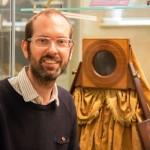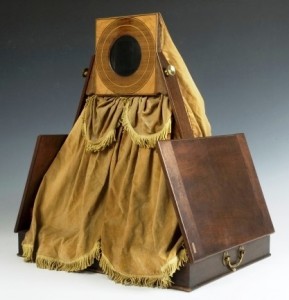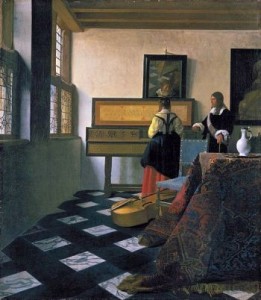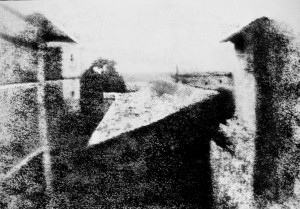 Camera obscura – Inventory no. 92218
Camera obscura – Inventory no. 92218
Scott Billings – Public Engagement Officer, Museum of History of Science
What is a camera obscura?
This object is quite magical. It’s called a camera obscura, the name being derived from the Latin for darkened (obscura) chamber (camera). This particular instrument is about 200 years old and folds away into a wooden carry case. It would have been used by a draughtsman for making sketches of scenes such as landscape or architecture and was especially useful for capturing perspective. Above a rather theatrical looking curtain, which encloses the darkened chamber, is a large lens mounted in a wooden panel. The lens captures light from the scene projecting it onto a mirror which is held at a 45 degree angle behind it. The mirror reflects the rays of light down onto a piece of paper or canvas laid out horizontally on the base inside the wooden box. The observer, shrouded by a piece of black cloth to exclude any other surrounding light from getting into the box, would then trace the outlines of the scene as seen projected onto the paper inside the chamber.

The image would appear the right way up because of the reflex effect of the mirror, but the wrong way round because of the inversion caused by the lens. So the artist would have to compensate by tracing the final image in reverse. A camera obscura is a very simple optical device and has been around for several hundred years although originally in the form of a pinhole camera. It was only from the early 17th-century onwards that lenses of sufficient quality were available to create the more flexible lens mediated cameras, the larger aperture allowing much more light in creating a brighter image.

The Music Lesson – Johannes Vermeer
There is plenty of evidence that past masters such as Canaletto and Rembrandt made use of the camera obscura but other artists may have been more secretive. For example, there has been much debate about whether the Dutch painter Johannes Vermeer may have used a camera obscura to capture incredible detail in his exquisite paintings of domestic interior scenes but there is no documentary evidence. The balance of opinion amongst art historians is that he probably did!
As well as artists, in the 18th– and 19th-centuries, the camera obscura was useful accessory for the wealthy to take on the ‘Grand Tour’ to make drawings of Italian landscapes or classical ruins deepening the experience of aesthetic appreciation.
The camera obscura is useful for making drawings, but it is only focusing and reflecting light, not capturing it. The next big leap, beginning in the 19th-century, was to use a device like a camera obscura but to combine it with a material that would alter when exposed to the light thus preserving the image.

View from the Window at Le Gras – Joseph Niépce
The earliest known photograph, View from the Window at Le Gras, was taken in exactly this manner in 1826 or 1827 by the Frenchman Joseph Niépce using a camera obscura and a chemically-coated plate. So the camera obscura is a rather magical box after all – with just a hole and some light we have the basis for all photography, including, believe it or not, the camera in your phone.
Download the PDF of this text here.
